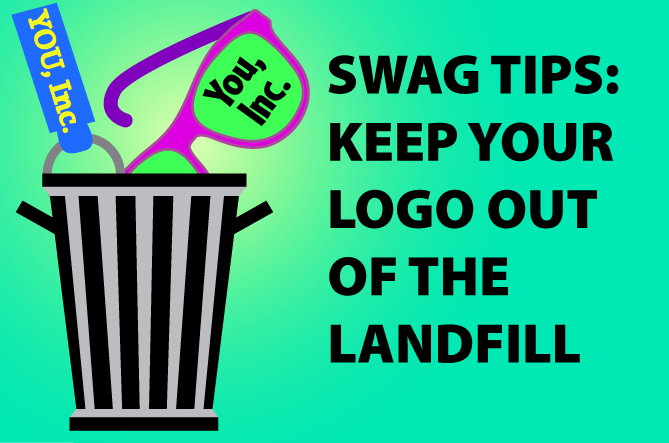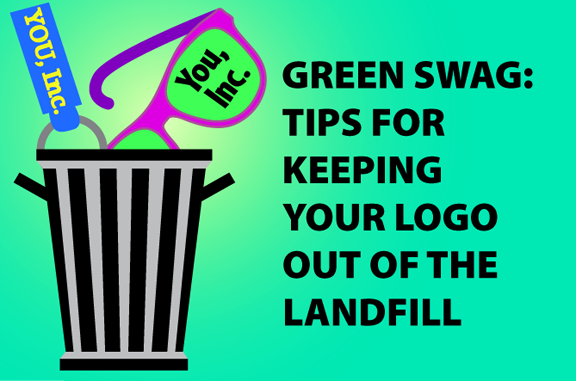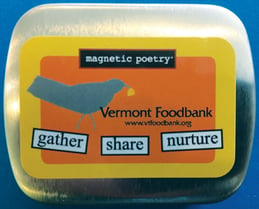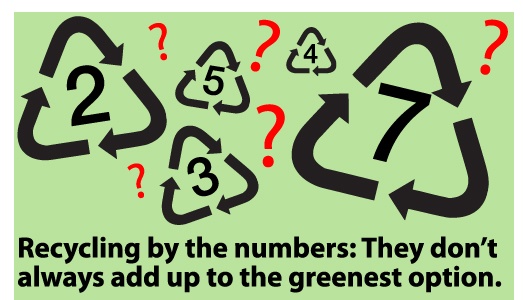How to Use Your Core Values to Inspire, Retain, and Energize Your Team
For the last few decades, but especially so in recent years, people are seeking out more than just an income from their place of employment. More...
4 min read
Clare Innes : 5/24/18 11:40 AM


Free swag! There's nothing like it to get people's attention at an event ... and there's nothing like that sinking feeling you get when you see those promo items, touting your logo, filling the trash cans at the exits. Let's take a look at how to keep your logo out of the landfill and still attract the attention of your target audience.
A study reported by Adweek confirms that promotional swag is one of the more effective means of getting attention. But there's a fine line between an item that walks your talk and one that tramples all over your brand. After all, your credibility is at stake if you're a triple bottom line, mission-based business with sustainability at its heart. You don't want your freebies singing a different tune to your prospective customers.
Information is your best friend when it comes to distilling true green from greenwash. For many items it's easiest to start on the disposal end of the lifecycle of your promo item, uncovering where your widget ends up after it has outlived its usefulness. Sound like a lot of work? Not really. Here are seven ways to make sure the swag you choose lives up to your organization's sustainability values:
Drop a dime. Call your state or local waste regulator. Here in Vermont, the Agency of Natural Resources website provides a basic list of what is recyclable. If you don't see your item on the list, a quick call will yield your answers. There is no national standard for recycling. A quick call to your local experts can put you on the right track. In our area, the Chittenden Solid Waste District provides a searchable A-Z List packed with info.

 Think evergreen. When you're choosing swag or trade show booth materials, opt for something that has enduring value and usefulness -- or playfulness, of course! Is it made well enough to withstand years of use? After all, you want whatever carries your logo to be valued and visible for as long as possible. At a recent conference, we picked up the Magnetic Poetry example pictured here; a great example of smart, customized swag from the Vermont Foodbank. It's a fun, enduring product that your customers will likely interact with for a good, long time. Once they're done with it, if they can't pass it along to someone else, the magnets and container are accepted at many scrap-metal recycling programs. The metal water bottle from Vermont-based Villanti Printers is all but guaranteed to show its logo for years to come.
Think evergreen. When you're choosing swag or trade show booth materials, opt for something that has enduring value and usefulness -- or playfulness, of course! Is it made well enough to withstand years of use? After all, you want whatever carries your logo to be valued and visible for as long as possible. At a recent conference, we picked up the Magnetic Poetry example pictured here; a great example of smart, customized swag from the Vermont Foodbank. It's a fun, enduring product that your customers will likely interact with for a good, long time. Once they're done with it, if they can't pass it along to someone else, the magnets and container are accepted at many scrap-metal recycling programs. The metal water bottle from Vermont-based Villanti Printers is all but guaranteed to show its logo for years to come.
Banners and display items are easy to revise for changeable information such as dates and times. If you use opaque banner material, a patch will be less noticeable. If you use a lot of banner material for your campaign, at least one company offers a take-back program for recycling certain types of large-format media.
Focus on packaging that is readily recyclable. Again, check with the experts. It's not always obvious what will and won't work in various recycling programs, in spite of claims by product purveyors. Two big no-nos are:
1. Filmy plastic is not recyclable in many areas because it's difficult to handle and it's hard to identify what type of plastic it's made from.
2. Packaging made from two or more materials, such as paper, plastic, and metal, can't be recycled. Case in point: Pringles-like containers with metal rims, foil interior, and paper exterior. 
The numbers don't always add up. Not everything with a recycling number is recyclable. Not everything WITHOUT a number ISN'T recyclable. The number only indicates what type of plastic an item is made of. That is only one of several characteristics that enable an item to be recycled.
The Federal Trade Commission's Green Guides set the rules for environmental marketing claims, such as recyclability and recycled content requirements, compostability, etc. That's fine, technically. But there are many vendors out there who, knowingly or not, make green claims that can't be fulfilled, even though it gets a green light in the Green Guide. That's why it's better to talk to the folks who run the waste system in your neck of the woods (see first bullet point), since they can let you know about a specific item in a specific area.
Is the event venue on board? If you've gone to all the trouble to make sure your handouts and give-aways are recyclable, it can be frustrating when the facility hosting the event does not make recycling available to attendees. If you're giving out sample bottles of your branded beverage, for example, you don't want that bottle, with your logo, in a trash bin, representing waste of a valuable resource. If they don't provide recycling containers, or you want to opt for a less wasteful option than single-use containers, choose an item associated with your beverage, such as branded bottle openers, koozies, coasters, and the like. Or, give out small samples and collect the cups for recycling or composting yourself.
You almost (almost) can't blame the producers who offer page after page of promotional items touted as "eco-friendly," "green," or "environmentally friendly" -- but who can't always deliver on their promises. Too often, producers of promotional items derive their claims on the existence of state-of-the-art recycling and composting facilities, or technicalities in the Green Guides, to fulfill their green claims. Unfortunately, such facilities are not available everywhere. Even where they do exist, they still can't take everything.
You've invested heart, soul, and organizational resources to establish your green credibility. The good news here is there is a healthy market and mindset for green products -- and that all the information you need to make the greenest choices you can is a phone call away.
Find out more
- Consult the EPA's WARM model, which tracks greenhouse gas emissions across a wide range of materials.
- Ask the hard questions (where did the materials come from? were they sustainably harvested? How much recycled material was used?
- Going compostable? Make sure it's certified by the Biodegradable Plastics Institute or ASTM D6400 or D6868 certified.
- A need-to-know guide to the FTC Green Guides from Greenbiz.com
- Advertising Specialty Institute study on the effectiveness of swag.
The Change Conversations blog is where changemakers find inspiration and insights on the power of mission-driven communication to create the change you want to see.
© 2009- to present, Marketing Partners, Inc. Content on the Change Conversations blog is licensed under a Creative Commons Attribution-Noncommercial-NoDerivs 3.0 United States License to share as much as you like. Please attribute to Change Conversations and link to ChangeConversations.
Creative Commons License may not apply to images used within posts and pages on this website. See hover-over or links for attribution associated with each image and licensing information.

For the last few decades, but especially so in recent years, people are seeking out more than just an income from their place of employment. More...

You know nonprofit organizations need websites just as small businesses do, but you may be surprised to learn nonprofit sites can be more complex and...

In today’s rapidly evolving media landscape, understanding where and how your story is told isn’t just strategic—it’s essential. How you communicate...